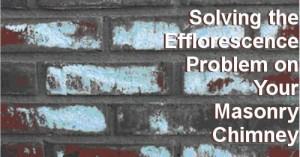Solving the Efflorescence Problem on Your Masonry Chimney
A common problem that homeowners with masonry chimneys come across is efflorescence. This appears as white powder that develops on the outside of the chimney. In actuality the powder is salt deposits left remain after excess moisture on the chimney surface has evaporated.
Is efflorescence a serious concern? Yes and no. While the salt deposits themselves pose no threat, whatever is causing them to appear, on-the-other-hand, is. This is usually one or more of the following: a cracked chimney structure, an improperly sealed chimney, or a chimney with no cap. Any one of these can lead to a buildup of moisture inside the chimney, which can lead to flaking and cracks in the masonry.
In other words, when damage is inflicted on the inside of the chimney, moisture is more easily passed through the masonry to the outside of the structure. When the water evaporates, it leaves behind the salt deposits or warning flags of the inner turmoil.
How Is Efflorescence Created?
There are three conditions that must take place inside the masonry before efflorescence can exist. One: water-soluble salts must be present. Two: a buildup of sufficient moisture to allow the salts to turn into a soluble solution. Three: A path must exist for the soluble salts to reach the surface of the masonry so the moisture can evaporate leaving the salts which then will crystallize and cause efflorescence.
If any one of these conditions is not present, then efflorescence cannot develop. However, as of yet, there is no economically soundproof way to remove one of the tree. Although, it is possible to reduce all three and make it nearly impossible for efflorescence to form.
When Are Masonry Chimneys the Most at Risk for Efflorescence?
Efflorescence can actually appear any time of the year, but as it is heavily influenced by humidity, it could be seen as more of a seasonal problem. For instance most people find that it becomes more of a problem after the rainy and snowy winter months. By spring it calms down, and when summer arrives it practically disappears.
Hire a Chimney Sweep for Annual Inspections
Each year your chimney should be inspected to determine its safety. They will check for any of these issues among looking for other structural damage and warning signs. If they notice any of these moisture problems, they will offer a solution, which could be as simple as replacing sealant around the cap or a more difficult chimney repair.
Cleaning Efflorescence
Although rarely harmful, efflorescence can still be unsightly on a chimney. Most of the time the rain will wash it away, but sometimes it is necessary to remove tougher stains. A chimney sweep has chemical mixes designed specially for taking care of this problem. They can also waterproof chimneys and install caps to keep the problem from arising repeatedly in the future.
Resources: Chimney Solutions, Delaware Quarries, Inc., Masonry Institute
Read for More Information:
Chimney Masonry Problems That Could Jeopardize Safety
Is Water More Dangerous to a Chimney Than Fire?
Chimney Masonry Repair: Why It’s Needed
Wells & Sons provides chimney sweep services to the Boyertown, Pottstown, Allentown, Reading, and surrounding Pennsylvania areas. Wells & Sons is also a full-service masonry contractor. Contact them today to schedule your annual chimney inspection or cleaning.









